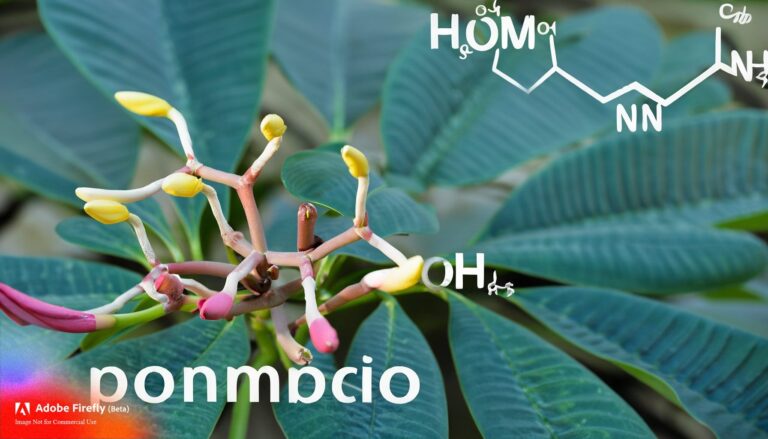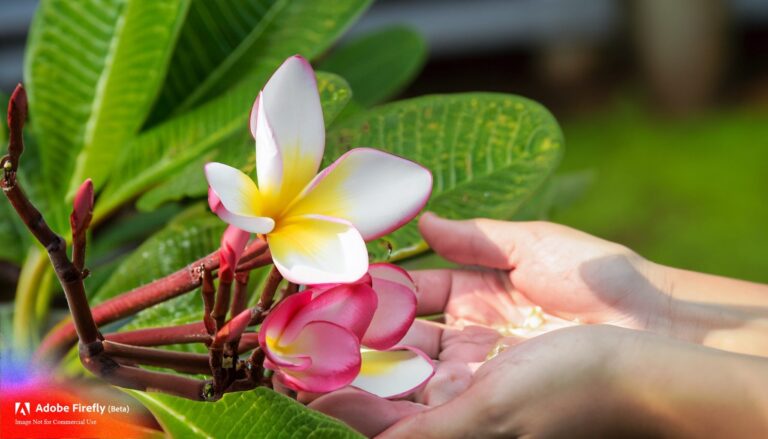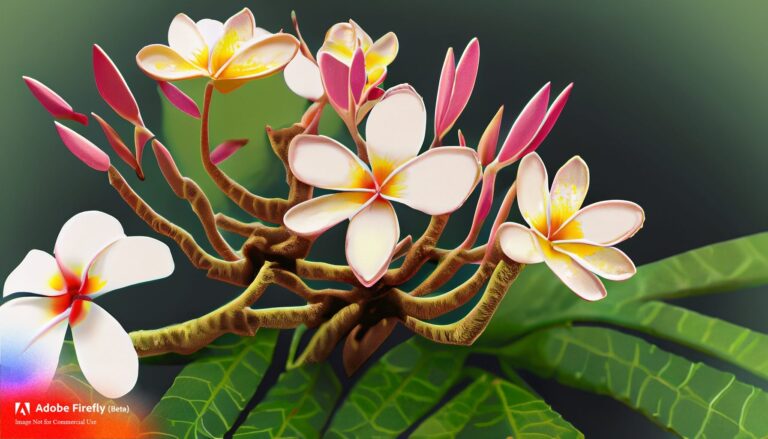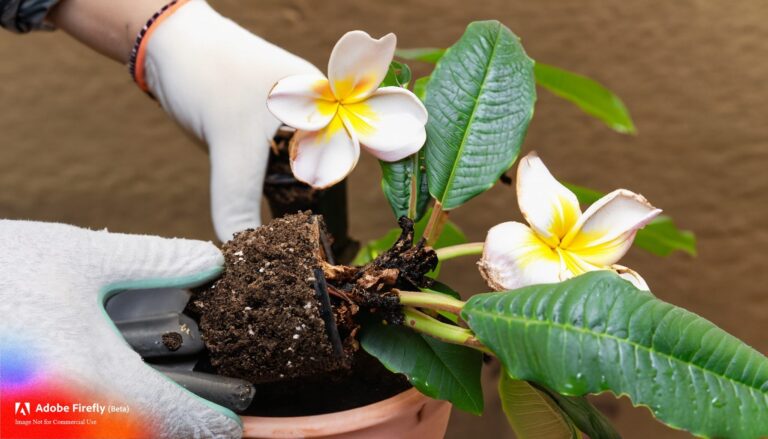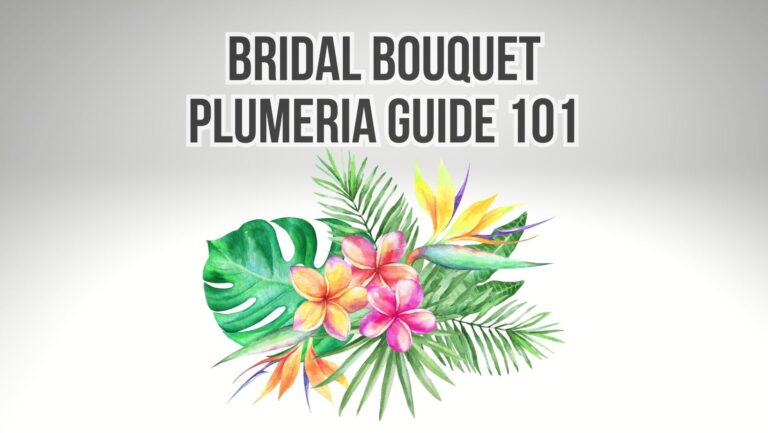
When it comes to plumeria plants, there are two common methods of propagation: grafting and rooting. Here’s a comparison between grafted plumeria and rooted plumeria:
Grafted Plumeria:
- Grafted plumeria refers to a plant that has been created by joining the stem (scion) of one plumeria variety onto the rootstock (understock) of another plumeria plant.
- The purpose of grafting is to combine desirable traits of one plumeria variety, such as specific flower color or form, with the rootstock’s beneficial characteristics, such as disease resistance or vigorous growth.
- Grafted plumeria plants tend to produce blooms sooner compared to rooted plumeria plants.
- They can be more expensive than rooted plumeria due to the additional labor and expertise required for the grafting process.
- Grafted plumerias can have a stronger and more reliable root system due to the rootstock’s established growth.
- Grafted plumerias are less likely to revert to their rootstock variety because the scion’s characteristics are dominant.
Rooted Plumeria:
- Rooted plumeria refers to a plant that has been propagated through root cuttings or by growing new roots from a severed branch or stem.
- Rooted plumeria plants will generally take longer to mature and start blooming compared to grafted plumeria.
- They are often more affordable than grafted plumeria plants since they do not involve the additional grafting process.
- Rooted plumerias may exhibit some variations in flower color, form, or other characteristics as they are more likely to retain the traits of their parent plant.
- These plants may require more time and attention to establish a strong and healthy root system.
Can You Graft Plumeria Plants? Is it posssible?
Yes, plumeria plants can be grafted, and grafting is a common method of propagation for plumeria. Here’s a general guide on grafting plumeria cuttings:
- Select compatible plants: Choose a healthy scion (the desired plumeria variety) and a suitable rootstock (a plumeria plant with a strong root system). Ensure that the scion and rootstock are compatible in terms of size and growth habit.
- Prepare the materials: Sterilize your grafting tools, such as a sharp knife or grafting blade, with rubbing alcohol or a bleach solution to minimize the risk of introducing infections. Have grafting tape or grafting clips ready to secure the graft union.
- Make the cuts: Carefully make a slanting cut at the base of the scion, ensuring that the cut is clean and smooth. Make a corresponding slanting cut on the rootstock, aligning it with the scion’s cut. The cuts should have matching diameters to ensure a snug fit.
- Join the cuts: Insert the cut end of the scion into the cut end of the rootstock, making sure they fit together tightly and the cambium layers (the green tissue just beneath the bark) of both plants come into contact.
- Secure the graft union: Use grafting tape or grafting clips to tightly bind the scion and rootstock together, ensuring the graft union remains stable and in close contact.
- Provide proper care: Place the grafted plumeria in a warm, well-lit location, preferably with high humidity. Maintain soil moisture without overwatering. Protect the graft union from direct sunlight or excessive heat, as it may weaken the union.
Advantages of Grafted Plumeria:
- Desired Traits: Grafting allows for the combination of desirable traits from different plumeria varieties. This means you can enjoy specific flower colors, forms, or fragrance that may not be naturally present in a single plumeria plant.
- Earlier Blooming: Grafted plumeria plants tend to bloom earlier compared to rooted plumeria. This is because the scion, which carries the desired traits, is already a mature part of the plant.
- Strong Root System: Grafted plumerias often have a stronger and more established root system because they are attached to a well-developed rootstock. This can enhance the plant’s overall vigor, growth, and ability to uptake nutrients.
- Less Reversion: Grafted plumerias have a lower likelihood of reverting to the characteristics of the rootstock variety. The dominant traits of the scion tend to prevail, ensuring that the desired qualities are maintained.
Disadvantages of Grafted Plumeria:
- Higher Cost: Grafted plumeria plants are usually more expensive compared to rooted plumeria. This is due to the additional labor, expertise, and time required for the grafting process.
- Limited Availability: The specific grafted plumeria varieties available for purchase may be limited compared to the wide range of rooted plumerias. Grafted plumerias are often produced in smaller quantities and may be less commonly found.
- Vulnerability to Rootstock Issues: Grafted plumeria plants are still dependent on the health and quality of the rootstock. If the rootstock is prone to certain diseases or pests, it can impact the overall health and longevity of the grafted plant.
- Need for Expertise: Grafting requires skill and knowledge to ensure a successful union between the scion and rootstock. It is typically carried out by experienced grafters or professionals. Inexperienced grafting attempts may result in failure or a weak graft union.
Advantages of Rooted Plumeria:
- Affordability: Rooted plumeria plants are generally more affordable compared to grafted plumeria. This makes them a budget-friendly option for plumeria enthusiasts or those looking to start their plumeria collection.
- Wide Variety: Rooted plumerias offer a wide variety of options in terms of flower colors, forms, and fragrance. They can exhibit variations in traits from the parent plant, providing a diverse range of choices for different preferences.
- Potential for Unique Characteristics: Rooted plumerias may produce unique or distinct characteristics that make them stand out. These variations can add a sense of novelty and excitement to your plumeria collection.
- Flexibility for Propagation: Rooted plumeria plants can be used for propagation through cuttings, allowing you to expand your collection or share plants with others. This provides an opportunity for experimentation and creating new plumeria varieties.
Disadvantages of Rooted Plumeria:
- Longer Time to Bloom: Rooted plumeria plants generally take longer to mature and start blooming compared to grafted plumeria. This means you may have to wait for a few years before enjoying the full beauty of their flowers.
- Less Established Root System: Rooted plumerias may have a less established or weaker root system compared to grafted plumeria. It may require more attention and care to ensure proper root development and overall plant health.
- Variation in Traits: Since rooted plumerias retain the traits of their parent plants, there can be variations in flower color, form, or other characteristics. This unpredictability can be exciting for some, but it may not meet the expectations of those looking for specific traits in their plumeria plants.
- Potential for Reversion: Rooted plumerias have the possibility of reverting to the characteristics of their rootstock or exhibiting traits from previous generations. This can result in unexpected changes in flower color or form over time.
It’s important to note that the advantages and disadvantages of grafted plumeria are not absolute and may vary depending on individual circumstances and preferences. Some people may find the desired traits and earlier blooms worth the higher cost and potential limitations, while others may prefer the affordability and potential variations of rooted plumeria. Ultimately, the choice between grafted and rooted plumeria depends on personal preferences, availability, and budget.
How Long Does It Take To Graft Plumeria?
Grafting plumeria cuttings can take several weeks to several months for the graft union to fully heal and establish. The success rate of grafting can vary based on various factors, including the skill of the grafter, the health of the plants, and environmental conditions.
Best Time To Graft Plumeria
The best time to graft plumeria is during the active growing season, typically in spring or early summer, when both the scion and rootstock are actively growing and have a higher chance of successful integration. Grafting can be attempted outside of this period, but it may be less successful due to the reduced growth activity of the plants.
It’s important to note that grafting requires some skill and experience, so beginners may want to seek guidance from experienced grafters or consult resources specific to plumeria grafting for more detailed instructions and tips.
Summary
Both grafted and rooted plumeria plants can thrive and produce beautiful blooms. The choice between the two often depends on personal preferences, budget, and availability. Grafted plumerias are favored when specific characteristics of a particular variety are desired, while rooted plumerias offer a more affordable option with potential variations in traits from the parent plant.

